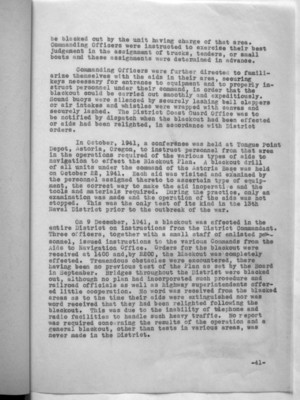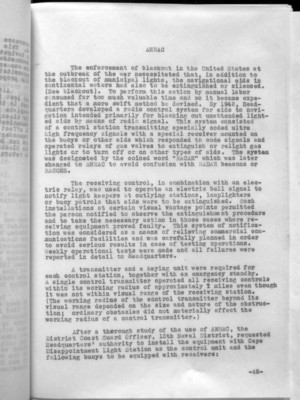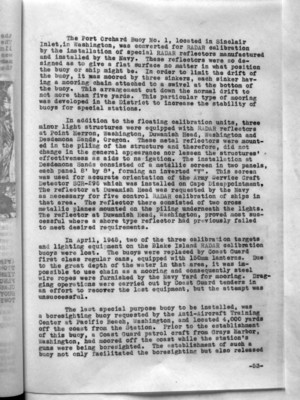Pages That Mention AIDS TO NAVIGATION
Coast Guard District narrative histories 1945
55
miles from Mason City to the Canadian border. A question arose as to whether or not Roosevelt Lake constituted part of "the navigable waters of the United States" as interpreted by the laws. In March, 1944, the Law Officer advised that Roosevelt Lake was navigable and, together with the Columbia River which flows into it and gives rise to it, furnished a water way for foreign commerce. With this fact established, it became necessary to establish aids to navigation along the lengths of this lake. At that time, there was very little traffic on Roosevelt Reservoir but it was the opinion of local marine interests that the traffic was bound to increase not only commercially but in pleasure craft following the war. Numerous hazards existed that made travel especially dangers under the conditions as they then existed. In a meeting between the Superintendent of the Coulee Dam and representatives of the District Coast Guard Officer, location were proposed for spar buoys to be anchored in the lake and provide the shortest run from Grand Coulee Dam to Kettle Falls, Washington. These locations were consistent with assumed limitations of 20 feet of water at buoy locations with a maximum reservoir drawdown at elevation 1208 and a minimum distance between the buoys 1/2 mile; the normal elevation of the reservoir when full is 1290. An investigation made by the Aids to Navigation Officer determined that 27 lights and 10 reflectors would suffice to mark the lake. The Bureau of Reclamation was in favor of the establishment of 51 buoys but the District Coast Guard Officer felt that buoys would be impracticable for several reasons. Due to the lowering of the water to different levels which would cause different shoal areas to appear and changes would have to be made in the buoys to keep the channel safely and effectively marked. Furthermore, the mountainous land area which formed the bottom of the lake together with the deep water, rendered use of buoys inadvisable; for in many places the buoys would be moored in over 200 feet of water which would require large buoys and, consequently, the services of a buoy tender. Unlighted buoys were not considered, for, as such, they would be inadequate. For these reasons then the Aids to Navigation Officer determined that the 27 lights and 10 reflectors would be adequate. These lighted aids would consist of a battery box on a concrete foundation with a 200mm lantern with a focal plane of 12 feet. Aids were to display a white light of 90 candlepower, flashing either every 4 seconds, 6 seconds or 10 seconds, and were to be serviced by the Seattle Operating Base twice a year with half of the batter cells being relieved at a time. The Bureau of Reclamation extended the use of one of its boats to be used in establishing these aids and in the servicing of them.
-35-
56
Work in this area was not begun until the later part of the Summer, but the operators, in the early Spring, began to urge that some assistance be given them as the waters were entirely without navigational aids and it was necessary to maintain a regular service including night travel in the transportation of lumber and direct war supplies. Due to the lack of lights, the operators were constantly damaging marine equipment and retarding the flow of this important traffic. Marine Inspectors had established Coast Guard Operating Regulations in this area and operators were finding it almost impossible to comply with these regulations under the circumstances. They pointed out that the installations of equipment such as were direly needed in the Roosevelt Lake were being made in other inland waters where cargo, generally, did not have the high war rating as in their area. They understood that complete coverage of the area could be made. In spite of the urgency of this request, the District Coast Guard Officer did not feel that temporary measures could be taken and, consequently, Roosevelt Dam aids were not established until August, 1945. The War Department issued a permit for a boom to be established below Peach to catch any drift from the Upper Columbia River before it reached the Dam. Brush so caught by the boom was to be dragged ashore and disposed of by burning. The boom was to be installed in two sections, one slightly upstream from the other, but overlapping its length so as to permit boats to pass around the ends of the boom on their way either up or down the river. Headquarters, at the request of the War Department recommended that the District prescribe such lights or signals as were necessary. The District Coast Guard recommended the reflector type lens which required no electric or automatic power for operation.
In December, 1944, a representative of the Aids to Navigation Office surveyed the area of Coeur d' Alene, Idaho, for navigational lights on the lake. As a result, it was determined that lights and reflectors were necessary as there was considerable traffic in lumber and war supplies. Before approval was received from Headquarters for these installations, a second survey was made, approximately six months later, to determine the exact locations. (It had been impossible and impracticable to spot exact locations in the December Survey.) The results of the second investigation were that 9 lights were proposed, subject to Headquarters' approval. Headquarters, however, did not favor the proposed program for aids to navigation in Coeur d' Alene as there did not seem to be sufficient traffic bearing on the war effort and also because the war was drawing to a close. (13 August, 1945). Headquarters indicated that if sufficient evidence was presented for the need for aids in that area at some future date, the program would be given consideration.
-36-
61
be blacked out by the unit having charge of that area. Commanding Officers were instructed to exercise their best judgement in the assignment of trucks, tenders, or small boats and these assignments were determined in advance.
Commanding Officers were further directed to familiarize themselves with the aids in their area, securing keys necessary for entrance to equipment and to properly instruct personnel under their command, in order that the blackout could be carried out smoothly and expeditiously. Sound buoys were silenced by securely lashing bell clappers or air intakes and whistles were wrapped with canvas and securely lashed. The District Coast Guard Office was to be notified by dispatch when the blackout had been effected or aids had been relighted, in accordance with District orders.
In October, 1941, a conference was held at Tongue Point Depot, Astoria, Oregon, to instruct personnel from that area in the operations required of the various types of aids to navigation to effect the Blackout Plan. A blackout drill of all units under command of the Astoria Base was held on October 22, 1941. Each aid was visited and examined by the personnel assigned thereto to ascertain type of equipment, the correct way to make the aid inoperative and the tools and materials required. During the practice, only an examination was made and the operation of the aids was not stopped. This was the only test of its kind in the 13th Naval District prior to the outbreak of the war.
On 9 December, 1941, a blackout was effected in the entire District on instructions from the District Commandant. Three officers, together with a small staff of enlisted personnel, issued instructions to the various Commands from the Aids to Navigation Office. Orders for the blackout were received at 1400 and, by 2200, the blackout was completely effected. Tremendous obstacles were encountered, there having been no previous test of the Plan as set by the Board in September. Bridges throughout the District were blacked out, although no plan had incorporated such procedure and railroad officials as well as highway superintendents offered little cooperation. No word was received from the blacked areas as to the time their aids were extinguished nor was word received that they had been relighted following the blackout. This was due to the inability of telephone and radio facilities to handle such heavy traffic. No report was required concerning the results of the operation and a general blackout, other than tests in various areas, was every made in the District.
-41-
65
The enforcement of blackout in the United States at the outbreak of the war necessitated that, in addition to the blackout of municipal lights, the navigational aids in continental waters had also to be extinguished or silenced. (See blackout). To perform this action by manual labor consumed far too much valuable time and so it became expedient that a more swift method be devised. By 1942, Headquarters developed a radio control system for aids to navigation intended primarily for blacking out unattended lighted aids by means of radio signal. This system consisted of a control station transmitting specially coded ultra high frequency signals with a special receiver mounted on the buoys or other aids which responded to code signals and operated relays of gas valves to extinguish or relight gas lights or to turn off or on other types of aids. The system was designated by the coined word "RACAN" which was later changed to ANRAC to avoid confusion with RADAR beacons or RACONS.
The receiving control, in combination with an electric relay, was used to operate an electric bell signal to notify light keepers at outlying stations, lamplighters or buoy patrols that aids were to be extinguished. Such installations at certain visual vantage points permitted the person notified to observe the extinguishment procedure and to take the necessary action in those cases where receiving equipment proved faulty. This system of notification was considered as a means of relieving commercial communications facilities and was carefully planned in order to avoid serious results in case of testing operations. Weekly operational tests were made and all failures were reported in detail to Headquarters.
A transmitter and a keying unit were required for each control station, together with an emergency standby. A single control transmitter operated all receiving controls within its working radius of approximately 7 miles even though it was not within visual range of the receiving station. (The working radius of the control transmitter beyond its visual range depended on the size and nature of the obstruction; ordinary obstacles did not materially affect the working radius of a control transmitter.)
After a thorough study of the use of ANRAC, the District Coast Guard Officer, 13th Naval District, requested Headquarters' authority to install the equipment with Cape Disappointment Light Station as the control unit and the following buoys to be equipped with receivers:
-45-
73
The Port Orchard Buoy No. 1, located in Sinclair Inlet, in Washington, was converted for RADAR calibration by the installation of special RADAR reflectors manufactured and installed by the Navy. These reflectors were so designed as to give a flat surface no matter in what position the buoy or ship might be. In order to limit the drift of the buoy, it was moored by three sinkers, each sinker having a mooring chain attached to a swivel at the bottom of the buoy. This arrangement cut down the normal drift to not more than five yards. This particular type of mooring was developed in the District to increase the stability of buoys for special stations.
In addition to the floating calibration units, three minor light structures were equipped with RADAR reflectors at Point Herron, Washington, Duwamish Head, Washington and Desdemona Sands, Oregon. These metal reflectors were mounted in the piling of the structure and therefore, did not change in the general appearance nor lessen the structures' effectiveness as aids to navigation. The installation at Desdemona Sands consisted of a metallic screen in two panels, each panel 8' by 8', forming an inverted "V". This screen was used for accurate orientation of the Army Service Craft Detector SCR-296 which was installed on Cape Disappointment. The reflector at Duwamish Head was requested by the Navy as necessary for five control RADAR calibration of ships in that area. The reflector there consisted of two cross metallic planes mounted on the piling underneath the lights. The reflector at Duwamish Head, Washington, proved most successful where a shore type reflector had previously failed to meet desired requirements.
In April, 1945, two of the three calibration targets and lighting equipment on the Blake Island RADAR calibration buoys were lost. The buoys were replaced by Coast Guard first class regular cans, equipped with 150mm lanterns. Due to the great depth of the water in that area, it was impossible to use chain as a mooring and consequently steel wire ropes were furnished by the Navy Yard for mooring. Dragging operations were carried out by Coast Guard tenders in an effort to recover the lost equipment, but the attempt was unsuccessful.
The last special purpose buoy to be installed, was a boresighting buoy requested by the Anti-Aircraft Training Center at Pacific Beach, Washington, and located 4,000 yards off the coast from the Station. Prior to the establishment of this buoy, a Coast Guard patrol craft from Grays Harbor, Washington, Had moored off the coast while the station's guns were being boresighted. The establishment of such a buoy not only facilitated the boresighting but also released
-53-




